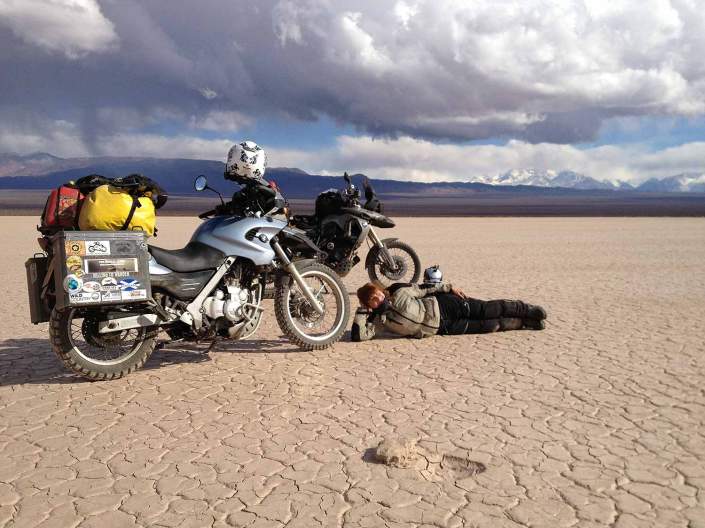Author: jasonspafford
26 Aug 2014 – A day of prickly pears!

Departing San Pedro for the fourth time funnily enough felt like the final time. We waved a fond farewell to a woolly band of domestic llamas, sauntering over the tarmac and grazing atop the hillocks against an arresting backdrop of Lickancabur volcano. It was Siberia, the wind was screaming at the top of her lungs and the air hitting us at punishing temperatures. Whether Mother Nature was ticked off at something, I couldn’t quite tell but she was determined to ‘get my knee down’ on the straight as an arrow desert ruta 27. I wondered if she was playing with me because the more I leaned into her, the more she pushed back. My grunts made those of Venus Williams during her US Open tennis tournaments sound like soft newborn whimpers.
There were no weathervanes, trees or wind socks present but at that moment, if I’d been able to perceive the wind’s movements with an equivalent infrared spray: namely its raging swirls, violent thermals, currents blowing from all directions, hostile gusts crossing this way and that, I would not have ridden my motorbike. This began as a blessing in disguise, short-lived and replaced with a white-knuckle ride, testing my resolve to bite through it and chew harder than I’ve ever gnawed before. I knew that six months previous, I would’ve ‘lost it’ – Pearl and my nerve would have been blown off the road. Now I was 15,000 miles into my riding career, two thirds of which comprised capricious roads and challenging conditions such as these. I was in no mood to give in so easily. The Venus Williams’ standard grunting continued, Jason pressed me to keep counteracting; leaning into an imaginary corner so lean on Pearl I did – against a vicious wind with an inner-strength I didn’t know I had.
Off the plateau we came, twisting tightly and descending around a corner. Low and behold, an oncoming white minibus driver faced me square on. Same lane. Both of us exchanged a startled split-second glance ‘What the hell…!’ and swerved at 40 miles per hour – me into the hard shoulder and him back into his own lane. There goes yet another of my nine cat lives, how many had I spent already? I decided not to dwell on my spiralling number of near misses.
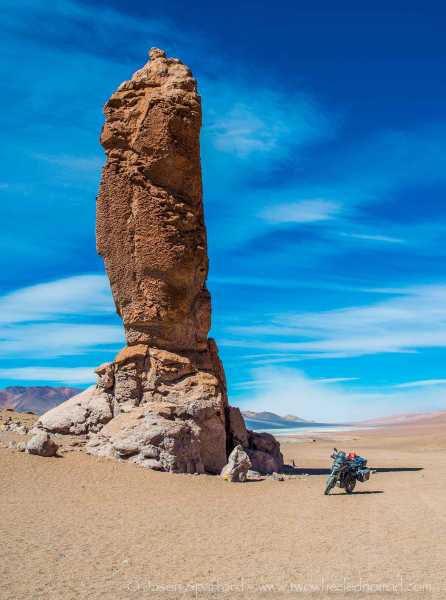
Our neck-straining efforts against the gusts were rewarded with a geological genital looking monolith, ‘The Indian Stone’, near Salar de Tararock. The last of our longed-for ‘Wish to see’ sights in Chile. It didn’t disappoint. Discovered by happy accident we were overjoyed despite our precarious position on a nearby plateau; it was still raining down a savage wind lashing at any traces of exposed skin. At least its substantial presence meant I could get a good enough look from afar – size on that occasion undeniably mattered. Approaching Argentina we were lulled onto a calmer road having left the plateau. We took a renewed pleasure in lifting the visors. Out of nowhere, a zooming freighter whizzed past and sandblasted us both in the faces. Still invigorated by the bracing wind and now exfoliated, these were the instant gratifications of two-wheeled travel.
At the border, a bonny Chilean lady who spoke superb English greeted us. She processed us in record time while remarking how well the pair of us must be doing in such merciless winds and cool climes. She winked at me as I handed her Pearl’s registration document and revealed, “I can’t even ride a push bike in this weather, I think you’re cool.” What a lovely lasting impression of Chile.
The next lady to process us at the counter assumed an officious persona. Lets call her ‘Miss Customs’. With a warm menace in her narrowed eyes, she sharply beckoned Jason over. No time-wasting pleasantries, her hard-boiled instructions were, “Come here. Documentation. Passport.” No problem señorita, as Jason handed her the said items with passport open on the photo identification page.
“Where is your passport number?” she bridled. I was surprised to hear the question coming from as official customs officer. She spoke swiftly in Spanish at Jason and her rhetoric was unmistakably clear, “Why are you travelling through South America without speaking Spanish? You don’t understand do you, do YOU?!” she barked in a moue of distaste.
“Er, umn, sorry”, Jason apologised – his eyes darting as his mind raced wildly with excuses.
“Why do you NOT speak Spanish? This is BIG problem”, she said with eyes that swam with rage. Jason simply stared back at this lady.
“Where are your friends that speak Spanish?”, she continues to glower down at Jason. Without coming up for air Miss Customs wanted to determine, “Which border you use to exit Argentina?”
“One closest to Salar de Uyuni, south of Bolivia.”
“Yes but what is the name of the border there?” The scowling intensifies another notch.
“I have no idea.”
“Urgh! How long are you staying here in my country?” Jason had already stated three months so confirmed this again in his most lucid Spanish.
“Mmn”, she bristled again with a look that could’ve boiled cheese.
Projecting a profound loathing of Jason whose face clearly didn’t fit with this woman, she continued to harangue him. It appeared she was playing a game of billiards with us as the caroming cue ball successively striking two other hapless balls. This was not going to end well. Or was she just sick and tired of foreign travellers whose Spanish was ‘work-in-progress’? I made a mental note to learn more of the language and rapido.
This woman was a study in ego. Jason sat on the receiving end of more unfathomably fast Spanish in a tone that was patently taking pleasure that what she was saying would not be understood. Miss Customs was getting her Schadenfreude-induced kicks in reducing Jason to a scolded child. She was a living Miss Trunchbull from Roald Dahl’s Matilda and Jason royally failing to please at Crunchem Hall Academy in standing before her. I had to hand it to her, she was enjoying herself immensely and a character I wouldn’t forget in a hurry. Jason was getting increasingly riled even if this individual was our gateway to the rest of our road trip. And as well, he really had no choice but to eat all this excrement and praise the taste; just bite your tongue Jason, graciously swallow it whole and smile sweetly. Miss Customs eventually processed Jason’s paperwork despite her reluctant misgivings. For her, he was clearly disappointing in the most gormless gringo approach possible. She had a tortured soul and I wondered what hidden truths lay beneath all that hostility.
As a ‘forgetting nothing and forgiving less’ type, I thought I better try and curry a little favour with this lady. Otherwise, I’d be toast. My turn. Oh Lordy Lou, here goes nothing. I tried to change tactics and initiated a well-intentioned conversation in the best of my limited Spanish. I knew full well she could speak a little English although being conscious of this fact was as useful as mudguards on a tortoise. I unleashed my most disarming smile under hopeful eyes and politely informed her in Española, “We speak a little Spanish but it is difficult when learning from zero. It is a pleasure to meet you in your very beautiful country and thank you so much for stamping my documentation.” To my surprise, she relaxed a little, measured out a small smile and responded, “No problem chica”. I was free to go.
Our final encounter before entering Argentina comprised a 20 minute wait for the barrier to be lifted. I asked a casually dressed young man in a sports cap if it would be possible to let us through. Boom! It was if I’d whacked a wasps’ nest with a stick. The guy exploded in a Spanish tongue, spat out that I needed my paperwork processing and gestured aggressively which way I needed to go. It reminded me of the sound of a hornets’ nest might make an instant before the hornets all came boiling out. It took everything I had not to get rankled and rapidly produced my stamped documentation. It seemed to semi-appease him somewhat and annoy.

We rocked up to Susques, a spit and sawdust settlement we’d once stayed overnight in the Jujuy region. Our hostel was called ‘El Cactus’, very befitting as the ladies hadn’t been overly obliging the first time round. What a comeback! Exhausted after a long day, we settled quickly in our spartan room and Jason thanked the woman. Cue a deadpan expression. Our heater didn’t work and in desert-dropping temperatures, Jase didn’t hesitate to appeal for one that emitted heat. Not too unreasonable? The lady liked his request not one iota. She threw a dart in his balloon of hope and waved him off like an irritating fly. Jase looked at me in despair to try the Morris powers of persuasion. I walked to the nearest unlocked and unoccupied room and helped myself to a functioning heater.
With our fair of share of warped misogyny and misandry consumed, we could only laugh about it afterwards. What an unparalleled obscenely comical day – there’s nowt as queer as folk.
Top Ten ‘Must Sees’ in South America
If you’re planning on visiting Argentina, Chile and Bolivia – here’s our ‘Top Ten’ offbeat travel hot spots:
-
Tierra del Fuego, Argentina
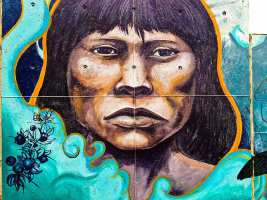
The southernmost city in the world, Ushuaia is the capital of Tierra del Fuego, Antártida e Islas del Atlántico Sur Province, Argentina. After some incredible hiking in this PATA-God-of-Peaks-GONIA, you surely won’t forget to have your photograph taken at the ‘Fin del el Mundo’ (End of the World) sign in Tierra del Fuego National Park – you may even spot a Fuegian red fox! While you’re there, why not indulge in a traditional asado with cordero (a barbeque with Patagonian lamb), visit the Harberton Estancia to learn all about missionary pioneer Tommy Bridges and the inspiring biologist Natalie Prosser whose museum she founded is home to some of the world’s finest specimens of whale, dolphin and other marine life. It would also be a missed opportunity not to visit the Ushuaia’s museums and immerse yourself in the lives of the Yámana and other Indian tribal peoples that lived in harmony for centuries.
-
Valle de la Luna – Valley of the Moon, Argentina
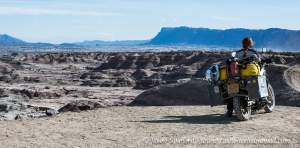
Ischigualasto Provincial Park, also called Valle de la Luna is a provincial protected area in the north-east of San Juan Province, north-western Argentina, limiting to the north with the Talampaya National Park, in La Rioja Province. Valley of the moon is a 630 square km UNESCO park, a desert valley that sits between mountain ranges Cerros Colorados in the east and Cerro Los Rastros in the west.
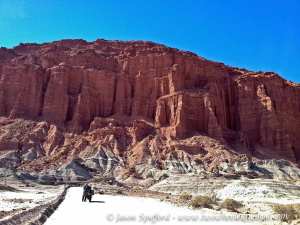
We rode into a sandy scene of cacti and rock formations steeped in rich mineral layers: creamy white calcium, pistachio green copper, bile yellow sulphur and terracotta-tinged iron, which looked super-imposed against a cloudless blue sky. During a 40 km paid tour on us astride our bikes following a procession of cars, we listened intently to how complete specimens of dinosaur skeletons had been found from the Triassic period, preserved so perfectly inside the layered sedimentary rock infused with its safeguarding substances. Fortunately, our tour guide Florencia was relaxed and allowed us to hang back, disappearing from view more oft than not and foremost the throng of tourists.
Over millennia at every meander in the canyon, the waters of the dry River Ischigualasto had carved shapes in the malleable red sandstone, monochrome clay and volcanic ash. I didn’t think much to the ‘submarine’ or ‘worm’ but rather liked the ‘Sphinx’ with an uncanny resemblance to a lion’s body wearing a woman’s head. It was an incredibly raw remnant of the Mesozoic Era, representing an ancient segment of our evolution. Riding around the place on two wheels was a fittingly first rate way to see the place although four wheels would suffice just as well.
-
Atacama desert, Chile
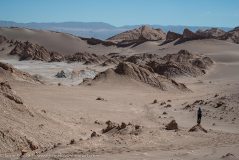
Atacama desert
The Atacama Desert is a plateau in South America, covering a 1,000 km strip of land on the Pacific coast, west of the Andes mountains. It is the driest non-polar desert in the world. San Pedro de Atacama makes an ideal base for daily sorties including: Salar de Talar, Valley of the Moon, Laguna Chaxa – a flamingo breeding site, Laguna Cejar and Laguna Tebinquinche near Ojos del Salar sinkholes and ‘The Indian Stone’, a geological monolith, near Salar de Tararock. There’s a wealth of wonderful sights to see in the Atacama, the place really got under our skin and it was a wrench to leave.
-
El Tatio, Chile
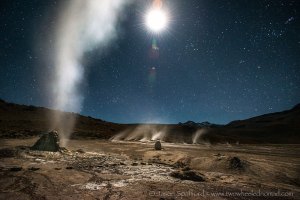
El Tatio is a geyser field located within the Andes Mountains of northern Chile at 4,320 meters above sea level. Its name means ‘the grandfather’. It is among the highest-elevation geyser fields in the world. You’ll be in geyser seventh heaven here. Fumaroles bubble all over the geyser field, plumes of scalding hot water gush upwards and arresting towers of steam rise from the rocks making a spectacular sight. There’s even a hot spring you can warm up your cockles in, it’s bliss. Just beware of early morning temperatures, which can go as low as -20 degrees Celsius! No one had a problem with us taking our wheels down onto the geyser field, we stayed mostly on the designated paths – what a rare ride out of the norm!
-
Salar de Uyuni, Bolivia
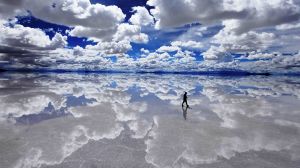
Salar de Uyuni is the world’s largest salt flat at 10,582 square km. Need I say more? It is located in the Potosí and Oruro departments in southwest Bolivia, near the crest of the Andes and is at an elevation of 3,656 metres above sea level. Superlatives are not needed for this astounding site…
-
Torres del Paine National Park, Chile
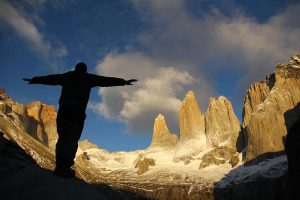
Torres del Paine – Towers of Paine.
Torres del Paine National Park is a national park encompassing mountains, glaciers, lakes, and rivers in southern Chilean Patagonia. What more could you ask for? The Cordillera del Paine is the centerpiece of the park. Hike the ‘W’ trail to get an intimate encounter with ‘The Horns’ and ‘The Towers’ but be warned, it’s an intense five day footslog of around 70 km. You may want to opt for the full ten day circuit, which lots do and love. Without stating the obvious, a
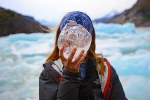
decent backpack and proper hiking boots are essential, I’d say so are dry bags too to hang your food in nearby trees when camping away from the pesky mice! The vistas however will have your soul singing so it’s worth the strenuous effort. Pack plenty of high-energy (lightweight) foods and second skins for those blisters.
-
Perito Moreno glacier, Los Glaciares National Park, Argentina
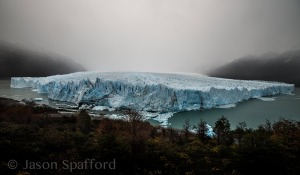
The neck-craning, jaw-dropping Perito Moreno Glacier is a glacier located in the Los Glaciares National Park in southwest Santa Cruz province, Argentina. It’s iconic and staggeringly beautiful that will send your heart soaring. The 250 km2 ice formation and 30 km in length, is one of 48 glaciers fed by the Southern Patagonian Ice Field located in the Andes system shared with Chile. This icefield is the world’s third largest reserve of fresh water. The Perito Moreno glacier, located 78 km from El Calafate, was named after the explorer Francisco Moreno, a pioneer who studied the region in the 19th century and played a major role in defending the territory of Argentina in the conflict surrounding the international border dispute with Chile.
-
Mount Fitz Roy, El Chaltén village between Argentina and Chile
The magnificent Monte Fitz Roy is a mountain located near El Chaltén village, in the Southern Patagonian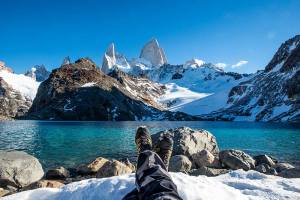 Ice Field in Patagonia, on the border between Argentina and Chile.
Ice Field in Patagonia, on the border between Argentina and Chile.
Taking a pre-dawn hour-long hike up to Lake Capri will give you a good warm-up. It facilitates a rich opportunity to watch the sun rise over Mount Fitz Roy from afar, part of the Southern Patagonian Ice Field. We stayed until the first light bathed the tip of the peak at over 3,400 metres; its meringue smooth snow was the whitest I’d ever seen. It was bitterly cold in May 2014 first thing but the German, Dutch and Argentinian trio of chaps accompanying us agreed, it was well worth the chilly 14 km walked.
If you’re anything like us, you’ll be itching for a closer look. The two of us took the 25 km round trek over to Laguna de Los Tres. This was about the closest we were going to get to Mount Fitz Roy, which afforded the most intimate vantage point overlooking the lagoon. As soon as we’d caught our breath from the slog endured to climb up there, the sight took our breath away once more. The lagoon was incredible, so clear and gorgeous – it was all I could do not to leap into those placid waters. Mother have mercy though, we were walking on hot coals for the last ten miles to get back – plodding heavily down unforgiving stones salted with white on the snow-speckled trail. These peaks of Patagonia certainly make you earn it.
Peeling ourselves away from El Chaltén, we rode alongside the sun-flecked waters of Lago Argentina for what seemed like an eternity. This lake was at least fifty miles long. As sure as eggs are eggs though, the smooth tarmac gives way to more interesting gravelly terrain shortly before Lago Cardiel. Enjoy!
-
Mano del Desierto – The Hand of the Desert, Chile
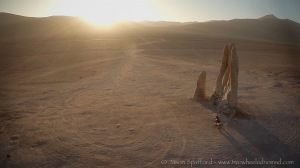
The Mano de Desierto is a large-scale sculpture of a hand located in the Atacama Desert in Chile, 75 km to the south of the city of Antofagasta, on the Pan American Highway. The nearest point of reference is the “Ciudad Empresarial La Negra”. A spectacular sight to behold at 11 metres high. It looked like a last vestige of a lost civilization. The entity as a whole put back an artful finesse into the striking sculpture that the mindless scribblings had tried to take away. Mario Irarrázabal the sculptor, symbolised the enigmatic sculpture as a sorrowful sentinel intended to evoke the tragic reality of the human condition. Emotions such as injustice, loneliness, human vulnerability and helplessness are embodied, it’s striking and unique.
10. Purmamarca, Argentina
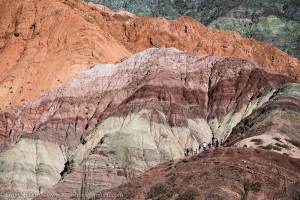
As a flyspeck town in the Tumbaya Department of the Jujuy Province, Purmamarca we re-labelled ‘Permanent marker’ is no broader than the tip of one. It sits against Cerro de los Siete Colores – the Hill of Seven Colours, which can only be described as a jagged rock formation resembling the marzipan fantasy of an over-zealous pastry chef. The village makes its coin by the congruent rainbow of colours interlaced through woven goods and handicrafts on offer. You could buy anything from a hat, poncho and slippers with a matching hippy handbag. A straggle of ochre adobe houses and age-old algarrobo trees next to a bijou 17th century church surrounded the hubbub of the central plaza. I loved weaving around the hills to get a better look at the place, coming away from the hordes of holiday-makers for a more relaxing ride by ourselves to just well, soak it all up.
22-25 Aug 2014 – Rewards and just deserts

My motorbike to me is many things. She’s so much more than my trusty steed; she’s my home, an unbelievable icebreaker, a ‘Get out of jail’ free card and sometimes a swift little lifesaver. She is decidedly my ticket to travel, enlightenment and empowerment. Without Pearl, I’d have a gaping hole in my soul, a chunk eaten away like the hungry bite of a sandwich. It suddenly dawned on me astride the saddle – my moving world – that on English soil, my view of the planet was constantly narrowed by the media’s perception. On the road, my outlook is shaped by a world of perspectives, constantly evolving because I am continually changing where I am. Travel for me is the one thing you can buy that will make you rich.

Packing up our ‘Dome Sweet Dome’, we meandered back from our intensive little visit to Mano del Desierto. Back in the saddle I cruised at an unrushed speed, not overly aware that Jason was feeling the fatigue a shade more than me. Seconds pass and unbeknown to either of us, he fell into a micro-sleep. At 50 miles per hour. To his horror, he wakes up to the jolting realisation of what had but more so could have happened sending a 240-volt shock through his core. In less than 20 metres, he pulls over under a ‘no arguments’ instruction from me after which Jase passes out on the roadside. He is soundly snoring seconds after his head hits the ground, assuming the stance of a slumbering starfish. It was a wake up call needed to shock us both into realising we were overdoing it. Best not let that happen again. Seeking refuge in Pearl’s shade and on bike watch, it seemed silly not to utilise the time in defuzzing my abandoned brows. A job long overdue!

It was time to leave San Pedro de Atacama, third time lucky. We’d probably be back, the place had gotten under our skin. Our aim: hit the Ruta del Desierto and ride the 145 miles on route 23 up to Paso de Sico. It was our exit plan from Chile on a more interesting road, a dirt one under construction. A sound plan being that our last border crossing at Jama – to get to San Pedro de Atacama – was a straightforward ‘Exit Argentina’ and ‘Enter Chile’ dual process.

As someone unseasoned in sand riding, I wasn’t exactly crazy over route 23’s abundance of sand and deep corrugations on our way to Paso de Sico. For some reason, I’d stopped advancing on the learning curve. In fact, I think I’d fallen off the damn thing. I was stuck on a skill level plateau having taken one step forward, two steps back. I was simply unable to take that incremental but crucial leap of faith astride Pearl; she and I felt every bone shaking, back jarring and suspension killing corrugation. Trying gamely to be strong fluttered off on my radar leaving my stomach cramped with frenzied butterflies; why couldn’t I ride this stretch of sand and all its unsavoury accomplices? The sand was insurmountable and I was task loaded. My confidence was shot, I was on a serious ‘off day’. I arrived at the border broken, saddle sore and sour. The border official’s first question was, “Where is your exit stamp from San Pedro de Atacama?”
‘You are kidding me senor. QUE?’, we both wondered as our grave mistake dawned on us. Pearl and I had just ridden the most gruelling off road riding to date and it had been a royal waste of time. I had to face the return ride the following morning, we were going nowhere. The error was all ours in not being aware about a ‘No man’s land’ of 145 miles between this particular border crossing – the size of some countries! We’d encountered a 20 kilometre long No man’s land between each of the country’s customs before now but not one of this distance. The Argentinian customs official at Paso de Sico explained that it costs too much money to run both the Exit and Enter processes at that particular border.
I was out of sorts with my rainbow of riding issues and waded deeper into a destructive thought pattern, blindsided by anger and frustration. In my mind’s eye, it was simple enough to process what Jason had been urging me to do while off roading but the physical application of such advice was hindered by waning confidence and clutching onto fear like a ragdoll.

Jase sat down and dropped a truth bomb on me. The bomb landed, exploded and after a delay I did quick search for mortal wounds. Finding none, I was left unscathed at least physically anyway. He gave me the pep talk of my riding career, spoke some harsh but necessary words and drilled into me where I was at. It brought home the magnitude of our undertaking, as well as the serious implications of riding slowly all day in desert isolation. Because of me our susceptibility of: being stranded in the middle of nowhere, provisions running dry and bikes failing from overheating and dangerously slow desert riding, was soaring. I didn’t want to hear it but needed to. We slept fitfully in sub zero temperatures at over 4,000 metres.

Dawn broke. I unwillingly awoke to feeling fearful of repeating the day on a fractious note of frayed nerves. I had spent the night jumping hoops through the 300 circus rings of my irrational imagination. After an acutely progressive ten minute warm up, Pearl tuned into my muscle memory kicking in. It was she that decided to take things into her own hands. I trusted her implicitly and have found time and time again that Pearl ends up saving me from myself. An hour’s ride into the return journey, unbeknown to me I’d lost my front mudguard, a crucial bolt off my sub-frame and one of my panniers had incurred a porridge explosion. Pearl had a different day in store for me, she showed me that opening up our shared potential was safer, less strenuous and put me in a heightened state of control. Despite the biting cold, I was warmed by the thought that a great deal of angst had been purified from my soul.
Jason yelled down the helmet intercom to slow down and said, “Lise, you’re riding like a pro today and I’m act-ually trying to keep up with you. See, you can do it.” It motivated and inspired me to keep forging ahead with the help of Pearl’s riding prowess although I do hope Jason abstains from calling me ‘Captain Slow’ again. I dared to dream the dream in a moment of unbridled ambition and thank Pearl, it paid off.

I looked around me for the first time. I was inside a pastel watercolour painting of soft textures, the landscape intermingled by a myriad of harmonious hues on the colour wheel. Chiefly creamy mochas, milk chocolate and swirling dark browns. I was staring fondly at an appetising arrangement of Guylian Belgian truffles longing to be savoured by my sweet-starved tastebuds. I was on a natural high in a slice of heaven and hungry for more of this sugar. Thanks to our unplanned blunder, we chanced upon Laguna Miscanti & Miniques. Two sparkling salty lakes, one was a blue curacao liqueur and the other starkly beautiful in its crystallised white but beckoning us by its inky midnight blue.

Not satisfied with luxuriating us in such phenomenally featured landscape, Karma took us next to Salar de Talar. Another glittering salty lake in the same aquamarine blue found in the Indian Ocean. Musing how far I’d come, I dangled my legs over the edge of iron red rocks, perfectly rounded and smoothed by the blasting winds. If these gleaming colours could be prescribed as treatment, medical bills would pail into insignificance.
The same route back was velvety; it was a breeze to skim over the corrugations, glide over the sand and flash over the coarse gravel. Where was that vexing road that had me in bits? I had no idea what had gotten into Pearl, she was flying me forward in a way I never imagined possible, not if the previous day’s standard was anything to go by. Jason asked me to “calm it” a couple of times; Pearl and I had never really ridden ‘hard’ before and it was fascinating to experience how it felt at a notch more speed. I was on the edge, for me anyway. It was easier, less taxing on my body and a purge for the soul. Pearl thanked me no end for keeping up with her desired pace. The pleasure was all mine. It put me on a new peg of riding contentment. It deepened my understanding – my skill level had reached a plateau and I finally claimed a right to pass it.

18-21 Aug 2014 – High five to the desert hand

Someone I once had to work alongside casually inquired where I took my main summer holiday one year. After outlining a fortnight’s touring the north west coast of Scotland on two wheels: with a bunch of male biking friends, living out of two panniers and a roll bag, wild camping most nights and covering around 3,000 miles, they informed me with a startling assertion as to how utterly horrendous that must have been. I couldn’t have related less to a person at that moment. I surmised one person’s version of horrific is another’s idea of heaven but could only wonder what they’d be thinking of someone doing this full time? I suspect it’d be uncomprehendingly challenging for them or worse still, trigger an irrecoverable meltdown from shock. I do hope that hasn’t happened.
Taking deep lungfuls of unburdened air in descending El Tatio’s dizzying heights back to a more sane 2,300 metres at San Pedro de Atacama was well, a breath of fresh if not fuller air. No sooner did my argument with altitude recede when Pearl lost her ability to provide a functioning front brake. Mayhaps she needed more attention than I was giving her. Despite our return journey requiring us to come down 2,000 metres with only a back brake and gears for control, it didn’t render panic waves on the radar. Truth to be told, I was too happy to be back astride the saddle bearing witness to deep yellow grassy plains curving in from the left and red rock rearing up from the right against a blindingly blue sky. Landscape of this simple but immense magnitude in a three part colour scheme set to ‘vibrant’ was a tonic to the system. Having only 50 per cent brake power was a triviality that wasn’t going to forestall my day. Pearl was performing to the best of her two wheeled ability, which left me grateful to the point of not gloating. Getting Pearl fixed would be a routine matter of mechanics; a bit of brake fluid and a tot of oil to once again bring her up to par.

We left sunny San Pedro de Atacama in the early twenties, our 190 mile ride to Antofagasta peaked preposterously in the mid thirties and cooled down into the mid-teens by a blowy sea breeze on arrival. The temperatures were starting to twist my melon, albeit in a bemused way. Hit by punishing gusts into Antofagasta, the wind became a lash as cruel as any bullwhip. Our first impressions of the port capital comprised an anti-climax of ghastly industrial sprawl amid retail park utopia, a haven for huge container ships all tantamount to a refuse site riddled with rubbish. What’s more, we soon determined a grim lack of affordable lodgings amid the shabby spread.
Within the hour, our attention was caught by a snug inlet of sandy beach, kids splashing their dads in the sea and mums content in their ten minutes off duty. A gregarious flock of pelicans were perched quizzically high atop streetlights, another basking in perfect harmony soaking up the sun’s last offerings. A little man who’d established himself a cozy residence on the beach within a tunnel in the wall, gestured to wrangle the amenable waterbirds like they were his own livestock. The birds seemed happy to oblige this quirky guy waddling on banded legs towards them, anticipating they’d be thrown a morsel or two from his bucket. I named him the pelican man.

Back in his stone wall side shelter, out popped a middle-aged lady clutching a month old puppy. Quivering in terror this poor little pup shone in the sunlight, its black glossy coat shimmering. I couldn’t remember last seeing anything so dinky, defenseless and ‘dunk in my coffee, could eat ya right up’ lovable. The lady was keen to let me have a hold, offered her up like The Lion King’s Simba to which I couldn’t resist the woman’s harmless intentions, sweet nature and sunny smile. As I petted the helpless creature with one hand in the vain hope of calming her in the palm of my other, the lady propositioned me, “You want it, have it! You want it, you want it!” With a sympathetic smile, I motioned towards the moto and apologised that it would be impossible. Although Pearl would trump over puppies any day, I thanked her all the same. I handed the babe back in her vulnerable state but looked longingly at the wide-eyed pup, where was her mum and what’d happened to her?
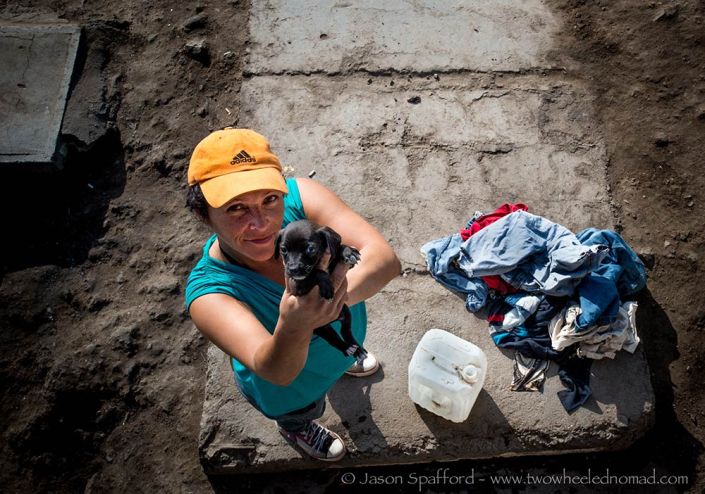

A few layers away from the coastline into Antofagasta’s centre, a man strode towards us with a visibly keen interest in making contact. We’d just made our fourth acquaintance in the space of forty minutes; this hodgepodge of a place wasn’t so unpleasant on second thoughts. Eager to marry us up with affordable accommodation, we raced to keep pace behind his Yamaha Tenere through a quaint, colonial and intimate part of the capital. The place came alive with moving colour; cheerful people pootling along, children hopping and skipping on their way home from school among people from all walks of port town life catching sight of us – wondering from where we’d originated while occasionally waving in our direction. There was much and more to this messy metropolis than initially met my eye. Blinkered, I guess I’d failed to lift the visor and look beyond the end of my nose.
Ashamed that I’d initially formed such a negative opinion of Antofagasta, I will know better next time. Jason expressed joint gratitude for our temporary guide’s troubles and although the guy’s choices of hostels were too pricey or fully occupied, we’d been given an interesting tour of his town we would’ve altogether missed. Back to the seafront just metres shy from the water’s edge, we pitched the tent and bedded down for the night to the soothing sound of the sea. The pair of us had forgotten how much we’d missed the sight of the ocean and of course what lies beneath. The day vouched to be a value-added one and as first impressions go, I relish when I’m so royally proved wrong.

Turning Pearl’s back on the Pacific, I loaded her like a pack mule and made a sharp exit as we sped onto the Pan-American highway without delay. We rode on route 5 through a haze of sand being blown by the mining in full operation. It was time to go and high five that hand projecting from the ground in the desert. Although plastered in artless graffiti from feet to over head-height, Mano del Desierto was still a sight to behold at 11 metres high. It looked like a last vestige of a lost civilization. The entity as a whole put back an artful finesse into the striking sculpture that the mindless scribblings had tried to take away. Sure enough, it was still deplorable to see such disrespect on display; this sight was easy prey for some reason – garbage infested and graffitied galore.

I put blinkers on my peripheral senses too, which composed a noisy racket of road train after relentless road train coming and going. A booming arterial highway running through a vast expanse of desert wasn’t really what I’d imagined; naïvely an absence of: buildings, conveyor belt of vehicles and civilization at the very least. Ugly mining excavation sites and cars in their truck load were however in abundance. Distraction deliciously took over when late afternoon light began to dance with the hand, drawing out pointed shadows from its elegant fingers and adding lustre to the location. We took our leave from the clamorous traffic and saw the sunset at the bottom of the hilly plateau, retaining a twilight view of the hand. No one knew of our whereabouts in the world, which more oft than not is just how I liked it.

Deeper into the dead of night, neither of us failed to notice the comings and goings of unexpected visitors. The hand became a magnet in attracting those that fancied a few drinks, a soirée with substances a lot stronger than Pisco Sours, some in-car frolicking and a smoke. We felt like brazen imposters trying to slink into the shadows of the place, go unnoticed and stay inconspicuous.

Dawn broke, all traces of delinquency had disappeared even if its vandalism and the party remnants remained. We woke up to the sun playfully flickering between the hand’s fingers. Jason got chatting to the hand’s newest guest, a Chilean ex-copper called Carlos. He now worked on one of the nearby mines and informally inquired whether Jason was alone. After learning I was tucked up inside the tent, he asked if I was sick. I had to laugh, may be I was sick to forego the first light; it was 7.15am and sadly I was still slumbering pushing up zzZs.

Carlos expressed a deep fondness for his country but was sickened by some of his own people that continued to show zero respect for what they have; namely go out of their way to deliberately deface sights such as the hand, protruding so profoundly on an isolated desert plateau. Irarrázabal the sculptor, symbolised the enigmatic sculpture as a sorrowful sentinel intended to evoke the tragic reality of the human condition. If emotions such as injustice, loneliness, human vulnerability and helplessness were being embodied, I couldn’t help wonder about the state of mind of those that had so visibly trashed something so striking and unique. Like the stains and imbecilic marks blotted over the the hand, it left a blemish on the experience.

15-17 Aug 2014 – Chile’s charms running hot and blowing cold

Upon registering Pearl’s mileage clock 10,000 miles, without conscious volition I stopped seeing our trip as an extended holiday. This had now become a way of life for us. The honeymoon period wasn’t altogether over, it was simply the start of a new chapter having learnt the basic ropes of two wheeled travel. Namely journeying into the unknown and coping with all its capricious twists and turns – coming out the other end all the richer for it. So far, South America was adorned by many pleasurable experiences mingled with the odd misadventure thrown in for good measure. We were able to carry all we needed on the back of two motorcycles, which wonderfully excluded all those unnecessary societal burdens. I’m done with those. My new mantra naturally emerged: to wring out as much fun from life in the most gutsy, earthy, rollicking, lip-licking way. Philosopher Alan Watts said exactly that – let go and be hung up on nothing and I would add, by nobody. We felt free.


The 50 mile ride from San Pedro de Atacama took us north longitudinally in ascent to the Antofagasta region. The sky was an animated arrangement of clouds straight from an episode opening of The Simpsons. En route to El Tatio, we were ungrudgingly slowed by a herd of goats consuming the width of the road. Watching the mature ones amble and kids toddling along bum-to-bum, my heart went out to commuters back home in murderous bumper-to-bumper traffic. Straggling behind a frisky band of bearded goats was my kind of traffic jam. In eventually skirting around the herd we blasted through our first ford; my lower half got drenched. The splash Pearl and I had created soaked my legs trickling into the top my boots. Over-zealous sprays and wet feet forgotten, we were favoured with clusters of vicuña dotted on the mountainous plains – a wild relative of the llama, supposedly valued for its fine silky wool. Like the llama, vicuña are a lot less skittish than the similar looking but larger guanaco. It gave us a moment to marvel at them in the altiplano Andean pastures against a brilliant blue sky backdrop.
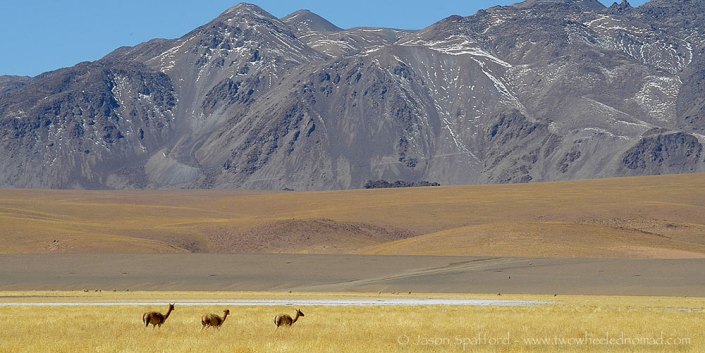

Pearl may’ve been crying out for some much needed attention but with everything else going on around me, I’d neglected to notice that a battery connection had become loose. I spent the remaining four miles towards our destination in anxiety of presaging disaster. Cue the rider involuntarily lurching and spotting someone’s resistance to ride, Pearl was not a happy soul. Ordinarily, I would have sought instant roadside assistance from my marvellous mechanic, Jason, only arm’s length away at my constant beck and call. But with only four miles to go, I gently and slowly coaxed Pearl over the day’s most unforgiving stretch of the coarsest corrugations, relentless ruts and up hill sandy struggles. She neither thanked me nor denied me; Pearl was forever my perfect riding companion. I owed everything to her and of course Jason’s prerequisite knowledge of what makes Pearl tick.

Back at serious elevation we rocked up at El Tatio, a geothermic basin. Pearl had out-performed herself on the high tableland’s tough terrain. Jason rapidly remedied her ailments giving us both peace of mind. Trying my utmost to shun the fatigue, dodge the dizziness and other bothersome symptoms of altitude, we surveyed our surroundings. “Oh look!” I said, pointing to four grey foxes advancing on reddish legs that were long staring at us if not any potential meals at hand. We were in geyser seventh heaven, thanks to the frozen underground rivers making contact with sizzling hot rocks.
I tentatively asked a member of the Tatio Mallku Society whose job it was to administer the natural heritage – a woman in charge of patrolling the activity around such fragile ground – if we might sleep in her stone floored office. She responded warmly by offering to accommodate our request for a negligible fee. This lady was in the winter of her days, she seemed obliging so I also inquired if there might be a hot shower nearby. She smiled knowingly, pointed a mile down the hill and kindly explained, “There is hot spring.” I laughed heartily at the self-evidence all around me and mentally applauded the utilisation of natural resources. Without toiletries in tow, we headed straight there for a cat lick and dip. By late afternoon, the ambient temperature had to be in single figures but what the heck, the pool was steaming away at a ‘Come to daddy’ 40 degrees Celsius.

Before reaching the hot spring, we took the time to recce the place. Fumaroles bubbled all over the geyser field, plumes of scalding hot water gushed upwards and arresting towers of steam rose from the rocks making a spectacular sight. Especially so, as we watchfully weaved through on the bikes. Towers of boiling steam were intensely striking early morning at the crack of sparrows, contrasting with the air temperature of -12 degrees and shrouding Jason amongst a sea of other bodies in an eggy stench of fetid vapours. I was content to give that one a miss despite being well-informed that typical temperatures started at around -20 first thing. Lucky Jason! At 4,320 metres above sea level, we were gazing on the world’s highest geysers. I had forgotten to bring my ‘boil in the bag’ rice, I’d just have to plunge myself in instead.

By dusk tourists were disappearing leaving the hot spring serenely still, just for us. My heart was racing and I found it difficult to slow my resting pulse; acclimatisation was strenuous work-in-progress I mused. My mind for some reason was behaving like a monkey, jabbering up and down continuously. Mindful? I’d had a gutful of my mind, it was all but at boiling point. The hot spring soothed and settled me. Its hot surface water caressed my neck, my body remained lukewarm below the waterline but once my toes gently disturbed the sand on the bottom, it got ‘feet hopping’ hot again. It stopped the compulsive musings compounded by the head-banging at elevation and emptied all thought from the hinterland of my mind. In leaving the 300 circus rings of my mental faculty alone, it quietened itself – like the tourist turbulent muddy pool upon our arrival; when left undisturbed sooner or later stopped rippling.

Clocks used to rule my weekdays; I couldn’t remember when I last possessed a sharp sense of time. As we reluctantly peeled out from the hot spring, our exit rudely brought home where we were: in desert-dropping temperatures post the last smile of sunset. I’d taken two minutes to dress that was two minutes too long. The hot aches in my hands came on with a vengeance – I never knew blood being beckoned back to one’s fingers could be such agony. My world vanished in a red roar of pain. On came that inexplicable feminine ability to produce tears without appearing to cry, face fixed in a frown. Ouch! The night was growing perilously cold and in a cloudless sky, a full moon floated fat and white as a snowball. After a fitful sleep the sun started to rise, it was good to see the light summoning the day from the dragging darkness of the night.

I surfaced like a bear roused from hibernation, lethargically coming out of my cocoon. Our one day sojourn in El Tatio extended into an unplanned second day. The afternoon saw us race back toward the geysers; there were over 500 of the thermal manifestations. A lot of them boiling away at 86 degrees Celsius, less than a kettle’s boiling point at sea level due to the altitude. How the bacteria survives in such scorching waters, I’ll never know. We stuck our fingers in as many bubbling mud pools, perpetual spouters, steamy waterholes and hot springs as we dared. With the Andean gulls soaring and not a soul in sight, Jason boldly sneaked a skinny dip as we basked in another tranquil bathe together.
Carelessly, we’d almost run our provisions dry. As I was about to prepare our only evening meal of porridge and powdered milk – making a mental note to restock the ‘rainy day’ dry shelf goods – the lady whose stone cold office we were camping out in, mercifully took pity on us. She urgently ushered me towards the staff kitchen with her arm sympathetically around my shoulder. Hoping she couldn’t hear my stomach growl, she gave us a simple square meal. After a 20 hour fast, it had to be about the tastiest spaghetti and sauce with a pannier-bruised avocado we’d ever chowed down. A befitting depiction of our two day stopover in El Tatio? A toe-tingling sizzler!
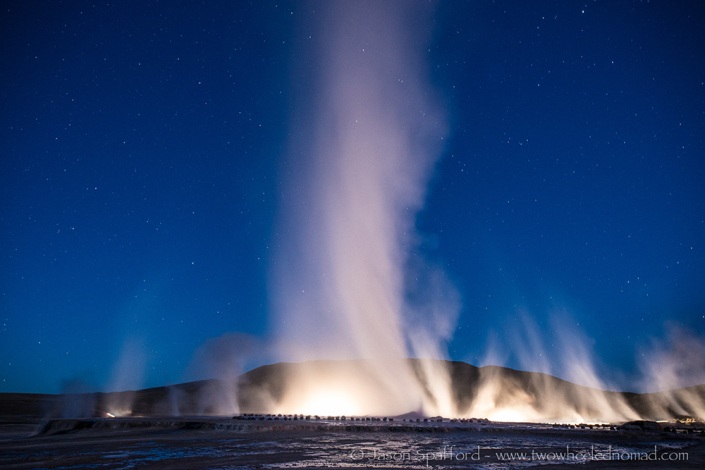
7-14 Aug 2014 – A Bohemian jewel in Chile’s Atacama crown

The beauty of having your own wheels means we executed our own sorties each day while using San Pedro de Atacama as a base. Our first self-facilitated foray into the desert took us to Valle de la Luna, Chile’s equivalent of Valley of the moon. I’d clocked the coaches carting around the day-trippers but thankfully the park was big enough to disperse everyone adequately enough. Its resemblance to the surface of the moon was remarkable, owing to its different stratifications and salt formations. We took ourselves on a cruisy circuit stopping when the urge took us; sauntered over the odd sand dune, bobbled over the bumpiest salt-stiffened road to date, siesta’ed in the sun post lunch and indulged in a light read. It was biking bliss. I overheard one young woman who, after completing a guided walk faced her tour guide and exclaimed, “Well that was absolutely not boring!”

A backpacking Canadian couple joined us for an afternoon’s banter and evening beer turning our ‘down day’ into anything but. It was terrific timing on the desert’s first overcast day since our arrival, and further brightened by an exuberant street carnival that made a peacock look drab. I took a shine to the pair’s easy-going personas, exhibiting a self-contained ease to be both interesting and interested. Our kinda people.

A bit deeper into Desierto de Atacama the following morning took us to Laguna Cejar and Laguna Tebinquiche. The first one was located near Ojos del Salar, a pair of sinkholes whose circular outlines were crystallised in salt the way a cocktail glass is sugar-frosted. The were puzzlingly positioned in the middle of an expanse of vast volcano-lined desert. It was like looking down into two pools of mint green liqueur. Laguna Tebinquiche was a lagoon whose resident flamingoes had taken flight elsewhere although the puna plover birds were in attendance. I’d taken my swimmers to see if I had the backbone to float in these salt-dense waters; turned out only my big toe had wanted to dip into the icy cold water while my back was contented to stay bone-dry.

We hung out in the desert oasis town for around a week, partly because Jason had ordered a shipment to replenish his depleted stores of quadcopter propellers. He was still mastering the artful intricacies of an airborne drone, battering both his blades and fingers in the delicate process: ‘learn by doing’. I couldn’t help but notice that it’d taken 36 hours for his blades to arrive into a flyspeck town in the desert; my parcel from the UK had been held by Argentina’s customs since the end of June. To my mind, it screamed out a health warning: Think twice before shipping products, any personal property or even paperwork to Argentina. The government will doggedly deter you from bringing goods into the country and a bit like all bad faith insurance companies, will put up grim persistence throughout a tireless resistance towards anyone fighting for what’s legitimately theirs. Passing traveller or not, whether they’re gifts over imported goods – makes not the merest of difference. Argentina use the word Aduana for their Customs department but the Department of Attrition would be far more apt.

Like Argentina’s mistreatment of its worryingly starved, street-wandering mongrels, I cared little for the country’s bureaucratic and seemingly corrupt customs. I’d been warned about sordid tales stemming from Argentinian customs from an ample number Argentinians, whose imported goods had been received by the department six months previous yet still not been released. Gifts sent to our Argentinian friends such as cases of wine from Australia had simply slid into obscurity. Despite these wrongdoings I still clutched to the thought like a child with a doll that being an international optimism-toting traveller, I could slip through the system and gratefully receive what was rightfully mine. The realist was starting to curse the inner-idealist in me. I could rant of robbery in an unusually vocal manner but it’d do me no good to brood on an all but lost battle. I’d have to park this troubling thought with a shrug of resignation, might be I’d have to write it off altogether. My rankled redhead required a ‘Worzel Gummidge’ replacement back to my old chipper one. There needs to be a new word for the gear change in emotions towards the ‘system’ responsible for ruining your untainted view of a country in a single moment.
I rudely digress. The diversity in the desert’s daily temperatures must be making my mind dwell on matters that will pan out one way or another. A route led us by luck to Salar de Atacama on a ride out somewhere further north. This in turn took us to Laguna Chaxa, which was about 65 kilometres from San Pedro de Atacama – one we’d been previously seeking with a fine-tooth comb but to no avail. En route, a Chilean couple stopped to lavish us in an unprecedented level of love, the wife Gloria all but devouring me whole standing at four foot and a peanut and Joberto, her husband happily handing over his Chilean address and full contact details to Jason, insisting on a plethora of photos before reluctantly taking leave of us. It was slightly overwhelming on that occasion but wonderful at the same time that people were enjoying the sight of the bikes and I guess us riding them through their country.
Laguna Chaxa was home to a flamingo-breeding site! Although three of five known species of flamingoes come to feed and breed there; James, Chilean and Andean, I was content simply knowing the wading birds were there at all. They were feathered in signature coral pink plumage with their protruding bent bills filter feeding in the lagoon.

Like the flamingoes, the Andean avocets were also pretty tame if not tolerant to our presence. Shorter legged than the flamingo, the avocet bird had an unusually slender upturned bill with striking patterned plumage to boot. It was a day for the zoom lens and snappy reflexes alongside a first for seeing a flock of flamingos in an awe-inspiring arc – departing one lagoon to a neighbouring sister pool. I lingered for as long as I could absorbing the setting like a soothing salve to a skin itch. In weaving around the potholes and patches of sand, I watched the dust devils dance to their own tune while Pearl speeds me back to our hostel. The evening’s supermoon was about a third brighter than other moons – made fractionally bigger as well from being a bit closer, thanks to a fairly uncommon courtesy of its elliptical orbit. All in all the day had been, well, a wonderful one.
Like a gutless wimp at the start of our next sortie, I fully assumed the weak will of a wuss. Destination: ALMA. Atacama Large Millimetre / Sub-millimetre Array. Eh? One of the world’s most important international observatories ever to be built and still being built. My position? Bottom lip out at the bottom of a volcano. Jason’s inner astro-geek was determined to find this revolutionary radio telescope sat upon the Chajnantor plateau – whose surface of its antennas is smooth to within the thickness of a human hair – by any means. The security guy in front of the barrier of the main road leading straight to the observatory, tersely insisted we would be going nowhere near his highly protected pride and joy. He was about as fun as a funeral. I understood a media pass that would take four weeks to issue as well as passing a medical with flying colours, would allow us to sail through security. That was about as feasible as squeezing silver from a silverfish.

An alternative route Jason had cursorily gleaned from Google maps, which scaled a volcano would however take us to our desired destination. According to a sketchy line on the satnav anyway. I suppose there had to be rain to get a rainbow; I conked out at the first sandy hurdle ascending up said volcano. No road as such marked the map, we were simply scrambling up sandy tracks that suggested a way toward its summit and ALMA thereafter. Pearl’s front wheel, like my first realisation sunk in without solace; I knew where I stood with the ripio, my ‘good to me’ gravelly friend. There was only a trace of ripio in sight. I therefore had to battle against a sizable lack of skill to tackle this sandy travail. It was standing in my way with a certain connivance. After a prolonged moment of doing nothing, Jason sat back and patiently waited to let me figure it out. Timely as it was, it was difficult to absorb Jason’s advice in my indignant state.

I was flooded with a natural buzz once I got going, albeit an adrenaline-laced shaky one. Admittedly I’d pondered too long and some ‘snotting and screaming’ in protest down the helmet’s intercom later, it was well worth the irrational fear I’d harboured but managed to relinquish. We carefully meandered around the volcano’s rough and tortuous edges, treaded over patches of snow and eventually reached a height on a par to Everest’s base camp. Over 5,200 metres in sub-zero temperatures but my my, it was beautiful up there. I felt vulnerable, dizzy at quite a torturing altitude and high on elevation. It was no wonder we were getting bloody nostrils with less oxygen making the air thinner, colder and drier. Just a few hundred metres from reaching the observatory, we met a barricade of sand. As someone that wasn’t a seasoned sand-rider, we were forced to turn around. Shame as Jason could have probably made it solo. On the return trail back, a smattering of smugness seeped in as Pearl somehow managed to avoid going down in the sand, unlike Jason who was filming me in anticipation that I would! Alas, we didn’t reach the desired destination of ALMA but having got as far as I had, was good enough for me.

3-6 Aug 2014 – Permanent marker, an argument with altitude & fabulous Fatima

Our lives six months after saying our heartfelt goodbyes in old Blighty – no longer concerned themselves with mainstream matters on which the average Brit might dwell: work, bills, making some imaginative weekend play before the cycle’s put on repeat. Our affairs now involved: getting from A to which B faring through foreign lands in often unpredictable conditions. Risk assessment, daily contingency plans, expectation management and damage limitation. As well, on-the-road health, our welfare in the wilderness and staying sane with each other 24/7 while riding a rollercoaster of emotions. Sourcing fuel for both bikes and bodies alongside motorcycle maintenance. Budget management where every purchase is a ‘considered’ one from shampoo to sprockets; wear and tear on our gear – can I live with the four finger holes in my gloves or would another patch job using dental floss extend their life a little longer? It’s a two wheeled nomadic life, which, I’ve said before – I love more than yesterday, less than tomorrow.

Why do I find it so thrilling to travel by means of motorcycle? Getting from A to B on all manner of terrain under my own steam perhaps? It was a gamble that I’d fare fortunately astride the saddle long-term but not all risks lead to ruin. I would have only brooded on the road not taken although threw plenty of oil on my fire of fear beforehand. Having already ridden over 9,000 miles I’m so puffed up with pride towards Pearl. Pray continue old girl. I love her like a person! It’s empowering to live on two wheels, it’s like nothing else in my former life on English soil. Total autonomy combined with flexibility governed only by an unquenchable thirst for exploration, coupled with letting go of all the controls that I hadn’t really harnessed to begin with breeds spontaneous excitement. And rich opportunity for firsts coexisting with the unknowns outside the comfort zone just waiting to be unearthed and experienced. Am I getting somewhere close to the answer?
No one day’s the same, the people we’re meeting and experiences we’re having is a life for which I think my soul had always yearned. The same applies to Jason. We’ve traded the life conventional for the ride of a lifetime. It’s already left me with a brighter spirit in which to retell tales on the road with a hungry gusto. I’m not sure if I’m riding to write or writing to ride, I think it’s both. It’s adding another meaningful layer for me anyway. I want a life worth living where it matters not how many miles I ride, nor what bike I ride those miles on or even where. Whether it’s a Honda C90, a Harley or even a Goldwing, the only thing that really matters is you’re enjoying yourself, mindfully. Truth be told, it’s the first time I’ve felt fulfilled…
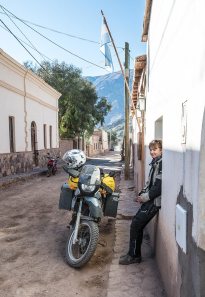

Salta on first impression was another biggish city screaming with traffic, noise and negligent road users. I would’ve been happy to keep riding but it was approaching dusk and I was ready for a rest. We spent a sweat-soaked hour ‘hostel shopping’ to accommodate our daily lodging demands – within a strict budget. It had been punishingly hot and sticky all day when I found out that my mother had suffered two recent mishaps – and on an empty stomach feeling capricious, I overreacted at something picking up on Jason’s grouchy tone. I had a grievance about God knows what and couldn’t let it go; like a mastiff with a bone I had to gnaw it down to splinters. The pressures of the day had been coiled up for too long – I royally fell out of favour with Jason. A long day on frayed patience.
We’d planned to stay in Salta for a few days on others’ firsthand recommendations – despite the odd colonial building glimpsed I had still wanted to make a sharp exit on arrival. Thank goodness for happy accidents. Salta’s silver-lined serendipity emerged through its BMW garage – Berlin Motos, whose employees accommodated Jason’s bike on the spot. They were pleased to replace a valve-cover gasket for just over forty pounds labour cost saving Jason the hassle, making some timely tweaks on top from recent wear and tear. It was the mechanics’ Saturday and they stayed open longer than their assigned half day for us. Superb staff that deserve the highest commendation.
Ruta 9 took us out of Salta onto a 4 metre wide road, not a single track but split into two lanes for oncoming traffic. Narrow was an understatement although we cared little and less; we were riding through 30 degree delight. The slender road snaked through a sub-tropical rainforest – it felt like we were following the frilly hem of a rah-rah skirt as we meandered through a multitude of tight twisties. All I could hear was the song of freedom that the wind sang as I fell into a pendular rhythm to its melodic tune. There were butterflies fluttering past my face, a crested caracara lunching on a lizard and a sparkling lake tucked off the main drag. We parked under cover of an ancient tree making a perfect picnic spot for our midday munch. It was not always but that day was a charmed one.

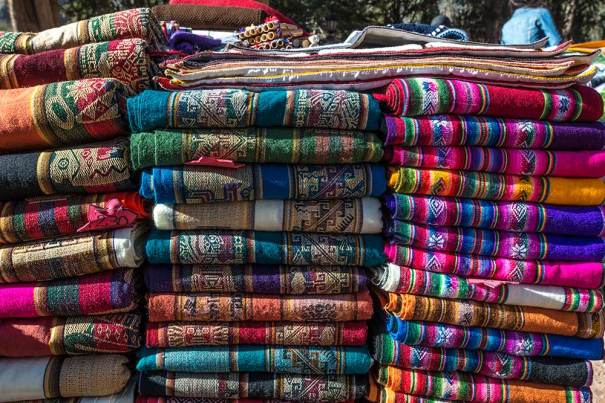
Purmamarca we pronounced as ‘permanent marker’ was no broader than the tip of one. As a flyspeck town, it sat against Cerro de los Siete Colores – the Hill of Seven Colours, which can only be described as a jagged rock formation resembling the marzipan fantasy of an over-zealous pastry chef. The village makes its coin by the congruent rainbow of colours interlaced through woven goods and handicrafts on offer. You could buy anything from a hat, poncho and slippers with a matching hippy handbag. A straggle of ochre adobe houses and age-old algarrobo trees next to a bijou 17th century church surrounded the hubbub of the central plaza.
The place was bustling with hordes of holiday-makers, although we found our own personal snuggery for the night away from the packs of people. Ensconced within the heart of the seven coloured hills we chanced upon a local guy whose beret barely covered his shock of black hair. He was somewhere in his fifties, placidly looked up with enquiring eyes while tending his four horses. This guy was unhurried in and unruffled by life. Some revealing chitchat later, we were cooking on the stove, sharing our coffee with Pedro and his two young apprentices with permission to stay over on private land; we laid out only the sleeping bags for a starry night’s sleep. Our wheels had won us the jackpot, yet again.

My ears the next morning popped to the sound of corn kernels bursting open. We surpassed the height upon the summit of Borneo’s Mount Kinabalu, over 4,000 metres – there’s a footslog I’d never forget. It wasn’t Everest although I was still light headed and short of breath between jumping in and out of the saddle to take pictures. The day ended somewhere off ruta 9 in the region of Jujuy at a spit and sawdust settlement, Susques. We joined the road workers at an unmarked café and chowed down a meal for less than two pounds. Bargain beaut.

Our day from Susques on ruta 52 had started at -7 degrees. In fact the morning saw our coldest day yet in the coolest of sunshine. Moreover we were riding at around 50 miles per hour, which further lowered the unforgiving temperature courtesy of the wind chill. The day previous, we’d been slathering on sun cream, wearing the minimal of clothing. I simply didn’t think ahead and dressed according to balmy breezes and a warm window of sun. I’d blown a fuse on my bike so thought nothing to donning a thin base layer as opposed to my heated jacket, temporarily out of action.
I confess, after an hour or two riding in a raw -7 without my heated gear I was running low on heat reserves. Wearing a face etched in anguish, I was cold as ice clad in goosebumps, every breath laboured. My hands were turning a purply shade of blue with a white band across my knuckles and joints where blood had taken its leave. I was starting to shiver uncontrollably while trying to fight my inner ‘ginger whinger’ rearing her ugly head. It was no good. I pulled over stiff as stone to warm my fingers on Pearl’s exhaust, but not before letting myself wallow in a pitiful but cathartic cry. My affinity with the climbing altitude left much and more to be desired; I guess peaking our ride at 4,800 metres was pretty high, almost on a par to Everest’s base camp. My heart was punching out every heartbeat, I felt fatigued and my skull was pounding in what felt like an expanding head. Get this helmet off! My weep was worth it. With the mini-thunderstorm on my face over, I glugged down my grogginess with water and drank in the vista before me.

The low sandy hills were all soft lines and gentle curves in calming hues of dusky pink, salmon and peach. They sat serenely on the outskirts beneath a perfect blue sky unblemished by not a whisper of cloud. It was a visual banquet that seemed to keep further brushes with altitude sickness or hypothermic symptoms at bay – although wriggling into additional layers on which I could quickly lay my hands helped. We re-entered Chile for the umpteenth time on ruta 27, destination: San Pedro de Atacama. The day’s misadventure had passed and it gradually got warmer as the afternoon wore on.
Rolling into San Pedro de Atacama was a whopping 30 degrees higher than the morning’s rude start. I looked ahead to the oasis town but on my left spotted volcano Lickancabur – not too difficult to miss at just under 6,000 metres – which if carved down the middle, one half belonged to Chile the other Bolivia. The town itself was a bohemian jewel in the desert. Geared up for the day-tripper yes but it still retained something special and pocket-sized about the place. I liked it.


Fatima warmly greeted us on arrival at Hostel Tuygasto. What a sweet natured, well-informed and helpful lady. Not comfortable until she had given me a tour of the premises, ensuring I knew how the oven worked, to manage the tricky door lock and which was the hot shower tap, was she at ease. She thanked me for early payment with a receipt, gestured if I had any questions waiting with patient eyes for my response and resumed her cleaning duties around the hostel’s courtyard. I couldn’t remember the last time I’d been accorded with such courtesies. She was nine years old! I could not have been more astonished if John Lennon had come along juggling lemon pies. I adored people like her, she melted my heart in half a beat and it didn’t take more than a thimble of sense to realise why – her father exuded a gentle bonhomie about a happy aura as well.

29 July – 2 August 2014 – Sun, sand and Salta!
Santa Cruz, Copacabana, San Jose and Londres (also known as London) – what do they all have in common? They’re all the names given to friendly little towns of dusty dwellings, doing their individual Argentinian ‘thing’, a world apart from their counterparts elsewhere on earth. Most boasted tree lined central plazas bearing ripe oranges and one had a cluster of trees whose trunks were patriotically painted in Argentinian flag colours – blue and white. Heat shimmers rose off the road as we rode through the aforementioned towns en route to Santa Maria, giving a dreamlike quality to our surroundings ahead.

Passing through Tinogasta was perhaps more memorable. It was akin to a waste disposal bin overflowing with litter; piles of plastic, used tyres and unwanted household items strewn about everywhere. Pretty this place was not. Around a corner, a snarling Alsatian flung itself towards Pearl and me. The pair of us was a split second away from being grappled by a voracious dog suffering clear anger management issues and sporting a love for wrestling moving motorcycles. I opened Pearl up and off we shot, just out of reach from the mongrel’s gaping maw. Phew. Yards down the street saw a bunch of ragtag lads charging on their mopeds, some being lairy wolf-whistling louts, others paying no one else any mind. A rowdy duo ‘two up’ in particular made me chuckle as the rider beamed a dashing smile my way and waved wildly, while the pillion gave me the finger. At least the motorcyclist was a decent chap!
In hindsight, Londres would’ve been a spot worth staying over in. We only stopped for the morning. It was a Spanish settlement home to some Inca ruins of El Shincal. We climbed one of two hillocks – aligned with the rising and setting of the sun – to survey the vast valley to the south. The mingling of deciduous trees and cacti-prevalent desert flora formed a fascinating ecological paradox. The sun was a white hot penny beating down like a fiery hammer, which in South America’s winter was perhaps another charming contradiction. It was the first day in months the weather had permitted us to strip layers of clothing and ventilate air through our suits, as opposed to locking out the cruel cold to keep the insulation in. Unlike Tinogasta, our passage through Londres caught us both unawares; we radiated in practically the whole town’s warmth towards us: waving, tooting on their scooters, kids running after us and people gravitating towards the bikes I guess to seek out a story and take back to their family and friends. I still forget how the bikes sometimes magnetise people to us, it’s marvellous.
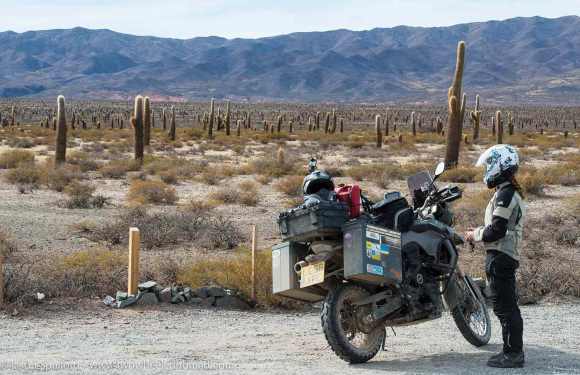
The Ruta del Adobe, the road of clay on Route 40 turned into the Ruta del Vinos, the wine road that took us to Cafayate. Argentina’s second largest wine region, which was as lovely as it was grapeless – go figure in South America’s winter. Cafayate to Cachi took us via La Vuelta a los Valles – Return to the Valleys. Oh my, what a ride! Valles Calchaquies oozed a seductive, off the beaten track rugged landscape. Perhaps the most soul-singing off roading we’d experienced in South America to date. We encountered: bee eaters flying above, gravelly sand, sandy gravel and well, more sand. Inevitably we stumbled through some rough patches of sand, me more than Jason. I performed a beautiful head slam into the sandy roadside at slow speed, had one of those ‘Pick yourself up, brush yourself off’ moments like a dog shakes water from its head. My helmet had come into its own, splendidly saving my noodle and some!



Up at one of the dusty settlements en route to Cachi, Jason met a guy who had fought for the Malvinas in the Falklands War. He showed Jason a big scar running down his thigh from being shot. Needless to say, he wasn’t too fond of Maggie Thatcher. Further on, we got caught behind a farmer’s flock of sheep up a stony hill. I cooed at the lambs although my attention soon got distracted by the sheeps’ shiny black balls popping out their rears like Mint Poppets at a chocolate factory, creating a handy breadcrumb trail for me to follow. I was so ravenous, they almost looked appetizing.

Vernacular architecture was common in the valleys that to my mind deserved some special attention – even I couldn’t fail to notice some of the adobe houses that boasted neoclassical columns and Moorish arches. Cachi was full of cobblestones, boasted a tranquil plaza overlooked by noble mountains and led us on a road that crossed the Parque National Los Cardones. Interestingly, the local furniture was made from the wood of cacti, cardon; in the treeless Andean foothills and puna, it’s an important timber source and can be seen everywhere up in northern Argentina. It has a distinctive Morse code pattern of dot and dash shaped knots running through the wood. A superb little spot in the desert and one I’m glad we took the time to deviate from our route to Salta and discover.

Our passage to Salta saw the prettiest proliferation of cacti I’d may be ever seen. In the space of an afternoon, the diversity of landscape became borderline ludicrous. One minute it felt as Mexico as cactus populated sandy plains can get and around a corner we peaked our ride at 3,300 metres to feast our eyes on Icelandic foothills. They looked completely covered in cocoa-powder – not what I expected after the desert scene previously encountered. We decided to deviate off road down a rocky track with the odd sheer drop and holes in the road; it got my heart racing as I chose a careful downward line in first gear. I narrowly avoided a steep ravine although had been practicing my weight shifting technique, which paid dividends on Pearl at that moment. Going back up was a piece of cake by comparison. A few miles further, we entered a New Zealand inspired Lord of the Rings scene that transformed into a sub-tropical rainforest, which in turn altered into Scottish hills and then lush green English farmland. All in the space of an afternoon. All in the smallest segment of South America – a slice of Argentinian pie I could continue to dine out on for months.


24 – 28 July 2014 – An idiot, a Rodeo without broncos & a Sphinx

Barreal’s playground on the crazy paving dried mud lake had been a hoot. We continued on ruta 149 but de toured eastwards for a pit stop in San Juan; Jason’s bike was screaming out for sprockets and a new chain. He was carrying a set from Santiago; it was just a case of replacing old for new. Jumping back on the 149 with a carefree spirit for the life unconventional, I sharply sucked a breath of air in as a four by four driver – evidently harbouring a death wish for himself and those jinxed mortals around him – made a kamikaze swerve around me, overtaking seconds before the brow of a hill. The oncoming car charging over the crest of the hill abruptly veered off road into the dirt to avoid collision, while I slammed both brakes on and did the same. All three of us had missed one another by a hair’s breadth. I felt nauseated by this idiot’s recklessness. The near miss threw me firmly out of the carefree camp and into a pensive one. Although I’d encountered worse drivers and had yet to come across a lot worse, spending another one of my nine cat lives was not to be shrugged off lightly.
On a side note about carnivorous mammals – riding over 8,500 miles in South America I’d so far: seen not one cat corpse but countless dead canines by the roadside, espied cadaverous looking dogs of whom are ubiquitous in Argentina and discerned if you stand still holding a sandwich for long enough, a mongrel with starvation swimming in his eyes will be peering up at you. To my mind, the absence of ameliorating the welfare standards of wild and stray dogs was one of the few things that besmirched Argentina.
I made amends with my morning’s narrow escape and my mood lightly lifted as the day wore on. Far off in the distance, sunlight shimmered off sapphire blue water. We stopped three kilometres outside Rodeo to have a look and kicked the side-stands down at Dique Cuesta del Viento, a perfect place to make peace with the world again. Shame there weren’t any kitesurfers taking to the wind or windsurfers whizzing past on this world famous reservoir, if naught else it was still beguiling as artificial lakes go.

Rodeo was a quiet sleepy town; folks sauntered along the street, while others strolled with an unhurried leisurely air. Unfortunately, the town didn’t take its name on lasso-swinging cowboys buckarooing their broncos but there were gauchos’ horses – belonging to Argentinian nomadic cowboys’, placidly grazing nearby. As I rode further, I peeked at picturesque adobe houses made from a kind of clay, many intermingled with small shack like shops advertising their wares or local fare on makeshift signs. The empanadas – a pastry crescent shaped parcel of hot minced: beef, onion, egg and olives – were full of flavour, fresh from the oven and cost pennies.

We chanced upon a hostel 50 Nudos off the village’s happily trodden track, which was as rustic and restful as it was idyllically remote. Even the big and little resident dogs scampered up to me without boisterously barking their chops off. The auburn haired, floppy eared sausage dog won my vote and I don’t ordinarily seek pooches out. With imploring eyes, I bartered an affordable rate with the hostel owner and thanked him with all the gratitude I had. Our budget wasn’t an infinite resource by any stretch and credit to this kind man, he needed his pricey rooms occupying in low season as much as we yearned a comfy bed.
Back on the renowned ruta 40, we’d ridden an inverted ‘V’ from Rodeo and had travelled north for half a day only to veer south again on the 76. Shrine filled caverns honeycombed the hills, as they so frequently did. Legend has it that during the civil wars of the 1840s Deolinda Correa followed her husband’s battalion on foot through the desert carrying provisions and her baby. Her supplies ran dry, she passed away from extreme hunger, thirst and exhaustion. When muleteers found them, the baby was reported to be suckling at the dead woman’s breast. Commemorating the miracle of the baby’s survival, shrines referred to as Difunta Correa (meaning ‘defunct’ and her surname respectively), symbolise her soul, one that performs miracles and intercedes for people. Devotees, particularly truckers leave gifts such as bottles of water to quench Deolinda’s thirst at said roadside shrines in exchange for supernatural favours, and this happens from Ushuaia all the way to La Quiaca on the Bolivian border.
The sienna coloured mountains and wild-west forked cacti poking up amid rusty red rock within Parque Nacional Talampaya made the long straight stint through the desert down to Los Baldecitas worth the wait. The lady of a fully occupied hospedaje – homestay directed us to a nearby shabby clay house situated on a sandy floor. At a fiver per person (in British pounds), we had everything and more we needed: a roof over our heads, an open fire and a Bobby Dazzler view of the desert with flocks of green parrots flying overhead.

The day had been a chilly one, we had set off in sub-zero temperatures only for a clear starry night to follow suit. When I tucked Pearl in for the night, pain shot up my legs as my half-frozen feet began to thaw in the warmth. I curled up around the fire with a wind-scoured face and a good book. Relaxed and subdued, I let my eyes devour the fire while the flames licked at my bread. Paperback in one hand and toast in the other, the blaze was all acrackle – flickering light dancing across the planes of our faces. More wood enlivened the fire, as fiery dancers woke within each stick of wood to whirl and spin in their glowing gowns of yellow and orange. I was done for another day.
A fresh 17 kilometre ride blasted out the cobwebs, as well as the sleep from our eyes and took us to Valle de la Luna. Valley of the moon is a 630 square kilometre UNESCO park, a desert valley that sits between mountain ranges Cerros Colorados in the east and Cerro Los Rastros in the west. It takes its name from the Diaguita word for ‘land without life’. We rode into a sandy scene of cacti and rock formations steeped in rich mineral layers: creamy white calcium, pistachio green copper, bile yellow sulphur and terracotta-tinged iron, which looked super-imposed against a cloudless blue sky. All that was missing for a spaghetti western movie set was the prairie-grazing cattle, fast flowing rivers and horse-mounted cowboys.
During a 40 kilometre paid tour on the bikes following a procession of cars, we listened intently to how complete specimens of dinosaur skeletons had been found from the Triassic period, preserved so perfectly inside the layered sedimentary rock infused with its safeguarding substances. Fortunately, our tour guide Florencia was relaxed and allowed us to hang back, disappearing from view more oft than not and foremost the throng of tourists.

Over millennia at every meander in the canyon, the waters of the dry River Ischigualasto had carved shapes in the malleable red sandstone, monochrome clay and volcanic ash. I didn’t think much to the ‘submarine’ or ‘worm’ but rather liked the ‘Sphinx’ with an uncanny resemblance to a lion’s body wearing a woman’s head. It was an incredibly raw remnant of the Mesozoic Era, representing an ancient segment of our evolution. Riding around the place on motorcycles was a fittingly first rate way to see the place.


Around and up one stony hill, our eyes settled on a octet playing traditional Argentinian music with a variety of string and wind instruments. Two professional dancers were also ballrooming to the tango. Their intense eye contact with one another, fixed postures and abrupt pauses made quite the surreal scene against a backdrop of rocky desert. I smiled as I sipped on a drop of complimentary Malbec enjoying the ambience – at that point I succumbed; ditched my helmet and donned the ‘tourist hat’. I imagined having the place to ourselves at night under a full moon would be equally as impressive – roaming on a moonscape of grey dunes in twilight. Eerie but enchanting…

A delicious languor was stealing over me while time stole away from us – by the time we’d slowly meandered over sand – me partly careening and Jason gliding – back to the park entrance, it made sense to return to our desert hideaway. The thought of another open fire and hot toast laced in Dulce de leche was too good to deny. Dulce de leche is a thick, toffee coloured milk caramel spread, which unlike dark green vegetables, can be found anywhere in Argentina. It’s so sweet that it will all but dissolve your tooth enamel upon contact. I was becoming dangerously addicted to the stuff. Wood laid and lit, the first flames appeared shy as a lamb, darting and dashing from tinder to log. Moments later, fire once again engulfed the hearth and us in a radiant heat. It was a bliss that blazed for hours, reaping from life’s elemental but nourishing charms.
14 – 23 July 2014 – Highs and lows: as many literal as metaphorical

Our seven-day sojourn in Chile’s capital was protracted because of having to stay put for parts to be replaced and spares to be shipped. Three weeks of languidly waiting around had come to an end. If there had been any quiet little moment of peace to savour about the late night drum beating, World Cup cheering, zoo-captive monkey howling city, it was upon reaching Cerro Santa Lucia. Smack in Santiago’s hustle and bustle, we chanced on an old park of steep stoned steps haphazardly lodged in a hill leading up to a stellar view. The hill was a remnant of a volcano 15 million years old.
Before tracing my way up, I came face to face with a goat head dominating an ornate vase, proudly protruding above the Neptune fountain. There was an unusual coolness emanating from the green oasis all about me, goosebumps spread at warp speed from wrist to shoulder. It felt refreshing, especially after returning from local ride outs with black marks smeared on my face every time – the air was that filthy. As far as soaking up a place was concerned, I was starting to feel like a dirty, saturated sponge. On the cobbles part way up I caught sight of a few hummingbirds hard at work, thrumming about the colourful bracts of a pink Acanthus flower. It was the prettiest part amid the urban sprawl I’d seen and treasured these gems to purify if not help redress my somewhat skewed view of this fume-fogged metropolis.
Swopping the hazy smogsphere that smudged Santiago and its litter lined roads for Andean mountainside brought us relief as our lungs inhaled long and deep on fresh Chilean air. The air we’d supped on over the last 21 days had been a noxious soup of God knows what spreading a miasma of odours that just weren’t able to dissipate in a clogged up city. Back on Ruta 5 towards Los Andes, a growing absence of vehicles coughing and spluttering gave way to a more oxygen-rich ride – acting as a filter for the brain, a way to ease my mind back into calm and untroubled thoughts.
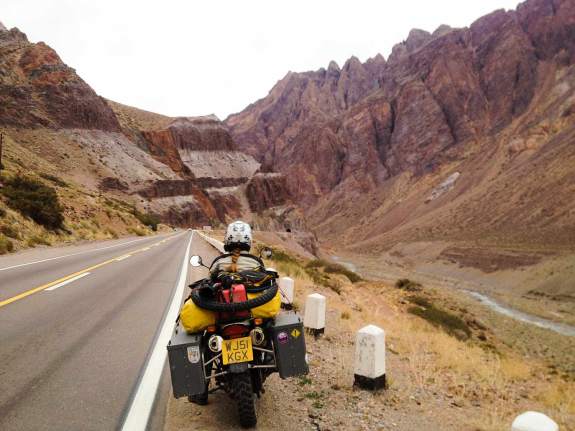
Our return ride to Mendoza was rudely halted on Ruta 60 just before being able to ‘get the knee down’ on the steep ascent of switchbacks up to Portillo, a ski resort on the edge of the Chilean border. Police informed us at the front of a roadblock amid a crowd from a long line of backed-up traffic that the delay would cost us an hour’s wait. Good time to feed our faces and chat to some likely locals. During the time it cost for Jason to grab us a bite to eat, a mere 60 minutes setback had turned into 24 hours. Bugger, we were going nowhere. An alleged imminent snowfall up at 3,200 metres later that afternoon meant that us road-users were forced to make alternative arrangements. Oh well, it could be worse.

A handful of coach-faring Argentinians sought to see if they could help improve our situation, eyeing our eagerness to continue. It was ridiculous to return to Santiago although pitching the tent just off the roadside didn’t altogether appeal either. Our provisions were low, we weren’t exactly falling over discreet places to camp and if snow and her icy sister were looming, my wheels and I would much rather be looking down on the steep zigzagging road, not up. While a few folks and I were attempting to unravel the most likely scenario across an interfering language barrier, a handful of ladies off the coach seized an opportunity to have their photo taken astride Pearl. It was an amuse-bouche she’d got used to dining out on and one which the ladies reveled in when Jason smiled as he gestured, ‘Roll up, roll up! Come on chicas, 10 pesos a go!’ His beckoning body language set them all to giggling.

Informed by a police officer at the barrier that if I could organise for the Portillo Hotel – a choice establishment catering to the Austrian Olympic ski team amongst other ski aficionado holiday makers – to call him directly and confirm our reservation, we were good to proceed. Well, granting us 15 minutes up the steep Scalextric track, a small boon at least. Sounded convoluted to me so I took a punt to proceed through the road blockade regardless. Hoping the police officer would tune into my pitiful puppy-dog eyed plea, I soon realised hell would freeze over before that man would bend to sense, let alone my will. The measured look I received told me that further beseeching him would prove as beneficial as nipples on a motorcross chest plate. Alas I needed to make that reservation. It didn’t mean we had to stay there or even check-in. If the Gods were good, the tunnel leading to the Argentinian border would still be open. The sky was a sun-lit cloudless blue and it was mild. The day promised to see an outbreak of sun-kissed freckles on my face than it did any snowfall.
The time it took to faff, deliberate, make the hotel reservation and land the police officer’s attention to depart, I imagined we could have missed the presumed snow and made it into Argentina, stopping for a Kodak moment with the southern hemisphere’s largest mountain Aconcagua en route. The prospect of paying through the nose for a 4/5 star establishment didn’t entirely flood us with joy. Without further delay, we zoomed past the accommodation and headed straight for the tunnel. We had missed its official closing by less than an hour. Double bugger.
Befuddled, we back-tracked to the hotel and met New Zealanders Monica and Dave in the same predicament as us. Although their wheels were powered by the thigh-burning pedal variety. Neither they nor us could afford to shell out for the only available lodging topside of the hill. Still stumped, I was furiously trying to formulate an idea when Michael the owner of the Portillo hotel ushered me to his private office. Utterly abashed but with nothing to lose I outlined our trip and quandary we found ourselves in with a budget that could ill-afford his standard rate. I proposed a promotional video of his hotel using the quadcopter in exchange for a room rate akin to our meager lodging funds. I was sure the manager would look at me as he might regard a dog who presumed to hump against his leg.
The conversation between us saw the manager: reveal that he loved our story-so-far, decline my proposition to trade Jason’s drone services for a cheap room and his enthusiasm to resolve our plight by an offer to furnish us with a $200 USD room for a sliver of the cost. The hotelier actually asked me how much I would be prepared to pay, which rendered me quite speechless. That was the last response I was expecting. The manager smiled as I pressed him a little further; he agreed to extend this generous gesture towards the cycling couple too. The Morris powers of persuasion had worked tenaciously on this occasion.
In the next moment, we trailed after the housekeeping lady like a procession of ducklings following the mother duck. Within the hour, all four of us were lording it over high tea, one of the four daily meals entitled to even a partially-paying patron, as we peered down incredulously at our ski passes. Refreshed, we wasted not a minute and basked outside neck-deep in a heated swimming pool. It overlooked the mountains under a star-twinkling night sky, steam blurring the beauty of the unforeseen magic that mingles with travellers from time to time.
The impending snow was a day late and wasn’t so much as a forecasted ski-worthy fall but a translucent smattering, lightly lacing the hillsides. The hotel employees’ dismay was ashamedly our delight. The roads remained clear and any ice soon thawed in the morning sun. We awoke to -4 degrees Celsius, departed Portillo mid-morning in 4 degrees and arrived to Mendoza late afternoon in a balmy 14. We’d experienced yet another snowed-in escapade although comfortably admit that we’d both had our fair share of fun on the snow and ice. Guess that’s the nature of Argentina’s wintery beast.
Re-entering Argentina from the Chilean side, we straggled behind half a hundred people keen to return to their home country. We stopped at what can only be described as a drive-thru border crossing. It took everything I had not to ask for two cheeseburgers with extra fries but being on the Chilean side, I thought better not. The best part of the afternoon had past for us to reach customs and them to process us through; with that drawn-out rigmarole under our belts, we were once again allowed on our way.
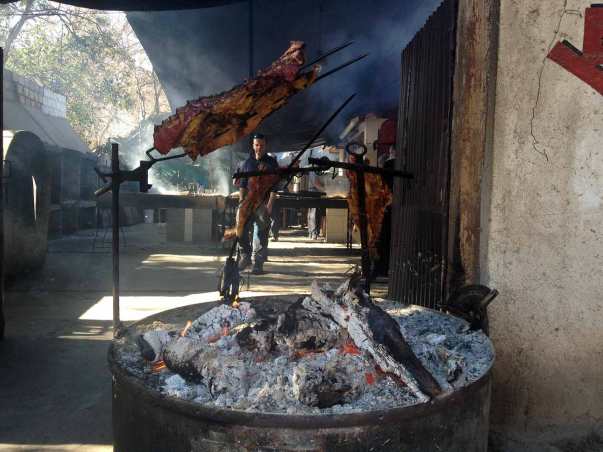
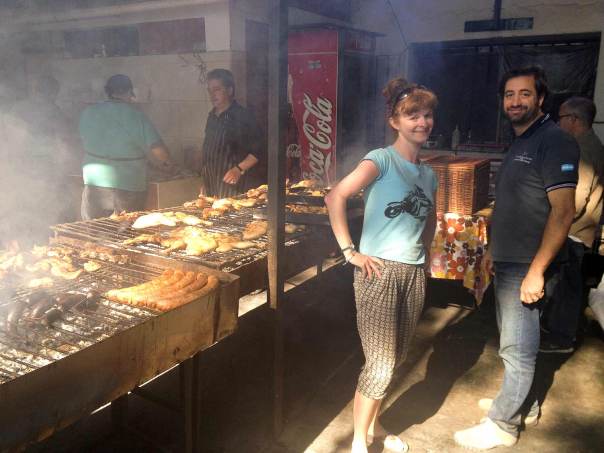
It felt as fine as it did familiar to return to Mendoza and reunite with our buddies we’d made the month previous. Although we weren’t full to the brim with exciting stories from our stay in Santiago, our Mendozian friends had just had a baby. I was smitten at least. During our stay, we feasted on more mouth-watering meaty asados and caught up with new acquaintances in the celebration of Argentina’s Día del Amigo, ‘Friends Day’ with Juan Pablo and his family. The weather had been so darn good, I’d even donned sun cream. A planned couple of nights turned into over a week at both Toto’s digs and Juan Pablo’s house; it was going to be difficult to leave Mendoza. We were rather sweet on these people and their place. It was a wrench to finally go and wave farewell although Pearl brought me round with her endorphin-releasing tonic, my RDA of mood enhancer. It was the balm my soul sighed for – as it always does, my ride.


No sooner had we swung a right westward off Ruta 40 back onto the 7 north towards Uspallata, when the cold became cruel. Icy raindrops started to drizzle and pesky pellets of hail began to pour down. My toes were fire-fighting the burn of the cold, all sensation slowly extinguished. Argentina’s autumn had gently kissed us; winter was now starting to bite us hard – its teeth snapping at any exposed strip of flesh. The saving grace was that it gave rise to quite a dramatic scene-stealer; dense clusters of brooding clouds, dark grey steely skies and the purply presence of the Andes with hoarfrost gripping at every low level bush was as Wuthering Heights as I was likely to see this side of the southern hemisphere. We got lucky and hit an unpaved track between the 39 and 412 roads – the first time I’d off-roaded smiling in the snow!
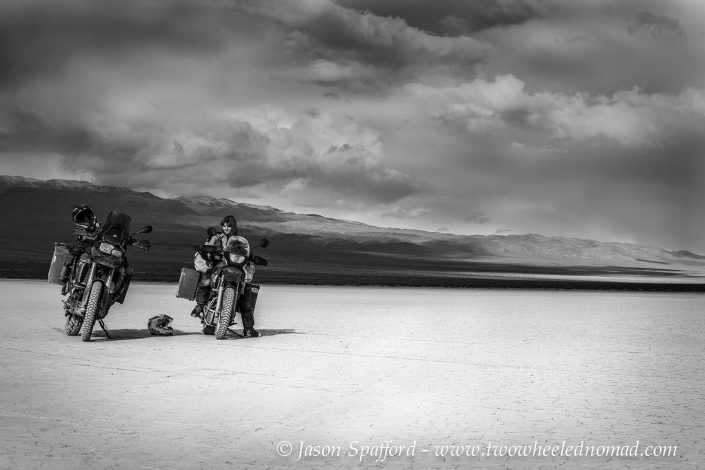

Arriving in Barreal that afternoon felt like someone had turned up the colour saturation in Photoshop. Up to then, I’d been blasé to the bland landscape of wind-tortured plains and dusty mountains, the appearance and texture of elephant skin and had no idea what lay around the corner. I’d read that this part of the San Juan province gave locals around 300 days of ultra-clear, pollution-free skies each year. Like a tap of a wand to a magician’s hat, out popped stark poplar trees, fiercely blue rivers running clear and an ancient, dried out lakebed ‘La Pampa del Leoncito’. Every square centimetre of the 10 kilometre mud-flat was a pattern of cracked crazy-paving. It turned the colour of Maldivian sand when the sun shone down. Needless to say, we spent nigh on an afternoon simulating spirals, figure of eights and playful attempts at crop circles leaving only traces of our tyre-streaked fun. Back in open country, a blending of the soul took place once again by means of my motorcycle and me. A courtesy Pearl never denied me.
